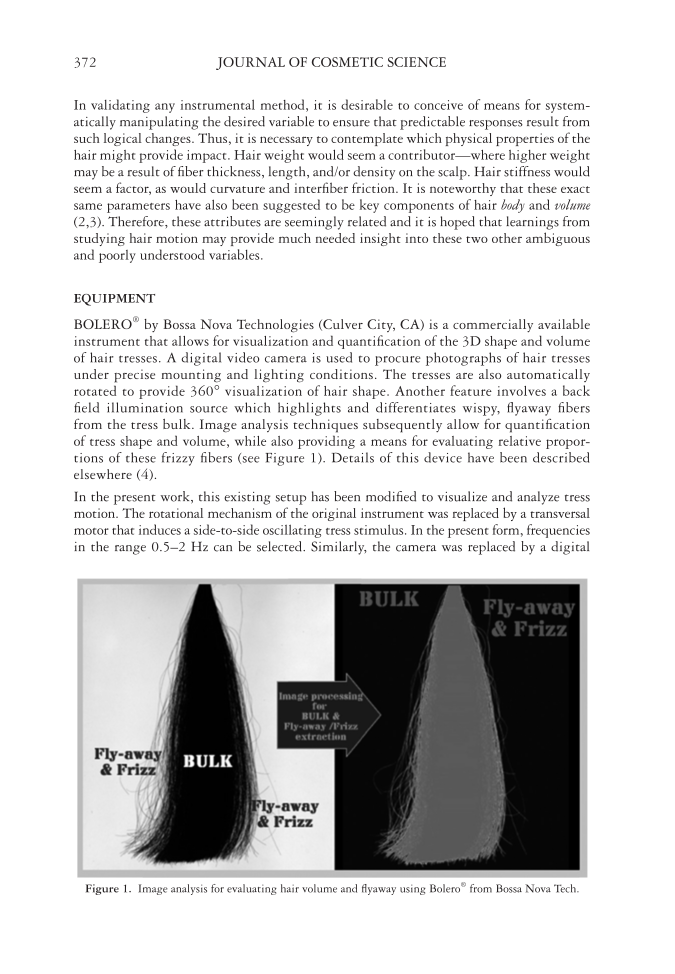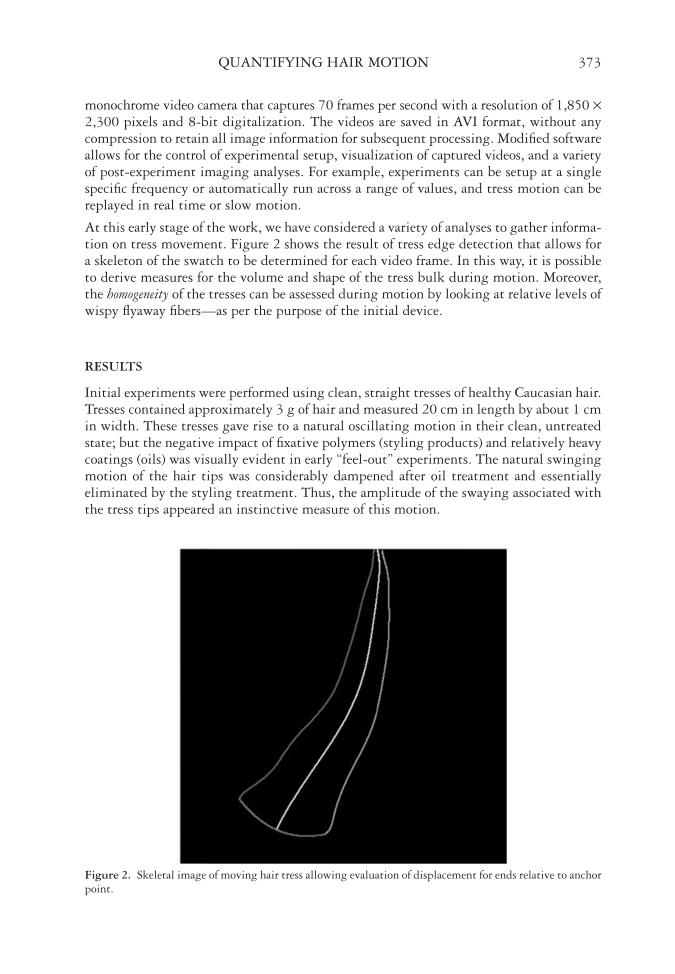JOURNAL OF COSMETIC SCIENCE 372 In validating any instrumental method, it is desirable to conceive of means for system- atically manipulating the desired variable to ensure that predictable responses result from such logical changes. Thus, it is necessary to contemplate which physical properties of the hair might provide impact. Hair weight would seem a contributor—where higher weight may be a result of fi ber thickness, length, and/or density on the scalp. Hair stiffness would seem a factor, as would curvature and interfi ber friction. It is noteworthy that these exact same parameters have also been suggested to be key components of hair body and volume (2,3). Therefore, these attributes are seemingly related and it is hoped that learnings from studying hair motion may provide much needed insight into these two other ambiguous and poorly understood variables. EQUIPMENT BOLERO® by Bossa Nova Technologies (Culver City, CA) is a commercially available instrument that allows for visualization and quantifi cation of the 3D shape and volume of hair tresses. A digital video camera is used to procure photographs of hair tresses under precise mounting and lighting conditions. The tresses are also automatically rotated to provide 360° visualization of hair shape. Another feature involves a back fi eld illumination source which highlights and differentiates wispy, fl yaway fi bers from the tress bulk. Image analysis techniques subsequently allow for quantifi cation of tress shape and volume, while also providing a means for evaluating relative propor- tions of these frizzy fi bers (see Figure 1). Details of this device have been described elsewhere (4). In the present work, this existing setup has been modifi ed to visualize and analyze tress motion. The rotational mechanism of the original instrument was replaced by a transversal motor that induces a side-to-side oscillating tress stimulus. In the present form, frequencies in the range 0.5–2 Hz can be selected. Similarly, the camera was replaced by a digital Figure 1. Image analysis for evaluating hair volume and fl yaway using Bolero® from Bossa Nova Tech.
QUANTIFYING HAIR MOTION 373 monochrome video camera that captures 70 frames per second with a resolution of 1,850 × 2,300 pixels and 8-bit digitalization. The videos are saved in AVI format, without any compression to retain all image information for subsequent processing. Modifi ed software allows for the control of experimental setup, visualization of captured videos, and a variety of post-experiment imaging analyses. For example, experiments can be setup at a single specifi c frequency or automatically run across a range of values, and tress motion can be replayed in real time or slow motion. At this early stage of the work, we have considered a variety of analyses to gather informa- tion on tress movement. Figure 2 shows the result of tress edge detection that allows for a skeleton of the swatch to be determined for each video frame. In this way, it is possible to derive measures for the volume and shape of the tress bulk during motion. Moreover, the homogeneity of the tresses can be assessed during motion by looking at relative levels of wispy fl yaway fi bers—as per the purpose of the initial device. RESULTS Initial experiments were performed using clean, straight tresses of healthy Caucasian hair. Tresses contained approximately 3 g of hair and measured 20 cm in length by about 1 cm in width. These tresses gave rise to a natural oscillating motion in their clean, untreated state but the negative impact of fi xative polymers (styling products) and relatively heavy coatings (oils) was visually evident in early “feel-out” experiments. The natural swinging motion of the hair tips was considerably dampened after oil treatment and essentially eliminated by the styling treatment. Thus, the amplitude of the swaying associated with the tress tips appeared an instinctive measure of this motion. Figure 2. Skeletal image of moving hair tress allowing evaluation of displacement for ends relative to anchor point.
Purchased for the exclusive use of nofirst nolast (unknown) From: SCC Media Library & Resource Center (library.scconline.org)









































































































